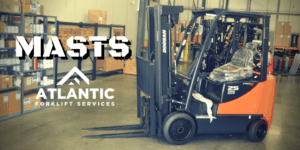Picture a forklift. What part do you think of first? Probably the cab. It’s the biggest part of the forklift. Then, probably the forks. They appear to do the bulk of the work, but the fact is the mast may be the most important part of the forklift.
The mast is the part of the forklift that moves the load up in the air using a system of pneumatic cylinders and chains that raise and lower the forks to different heights.
There are several types of masts, the right one for you depends on what you are moving around and how high the forks need to go: Two-stage, three-stage, four-stage, and five-stage. The addition of each stage allows the forks to travel higher. Obviously, the higher the forks have to go, the larger the truck will need to be to offset the weight. However, larger capacity trucks tend to skew towards the shorter masts because lifting a heavy load that high in the air is a bad idea. Check with your expert to determine which truck/mast combination might be best for you.
Like anything mechanical, your mast does require some routine maintenance and has its own section of the start-of-shift visual check.
At the start of each shift, check the mast thoroughly. Look at the bearings- make sure they are not digging into the rails they travel on. Check to make sure the parts of the mast that should be lubricated, are- but be aware that the mast rails for the most part do not require lubrication.
Also look for debris or anything that may impede the mast from raising and lowering.
Regular mast maintenance includes lubrication, and checking the lift cylinder to ensure it’s working flawlessly.
The mast is arguably the most important part of your forklift. There’s a lot to think about and to make sure you have all the answers to all your questions, don’t hesitate to reach out to our team of experts.

